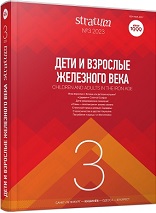Животные в погребально-поминальном обряде скифов левобережья Нижнего Днестра V—IV вв. до н. э.
Animals in the Funerary Rite of the Scythians on the Left Bank of the Lower Dniester in the 5th—4th centuries BC
Author(s): Elena P. Sekerskaya, Vitalii S. SinikaSubject(s): History, Archaeology, Ancient World
Published by: Издательский дом Stratum, Университет «Высшая антропологическая школа»
Keywords: left bank of the Lower Dniester; the second half of the 5th—4th centuries BC; Scythians; graves; archaeozoology
Summary/Abstract: This paper presents the results of a study of animal bones from Scythian burials of the second half of the 5th—4th century BC from the cemeteries “Vodovod” and “Garden” near the Glinoe village, Slobodzeya district, on the left bank of the Lower Dniester. The Scythians more often used bull meat (39.2%), a little less often — meat of small cattle (37.3%), and much less often — horse meat (19.6%) as sacrificial food. Horse meat and the hip cut of the carcass of a bull are more often marked in the graves of men; the shoulder — shoulder part of the carcass of a domestic bull were put in the graves of children and women. The vast majority of children’s burials were accompanied by the meat of small cattle, mainly sheep. The use of goat meat as sacrificial food is obviously a distinctive feature of the population that created the cemeteries Glinoe/Vodovod and Glinoe/Garden in the second half of the 5th—4th century BC. The lower boundary of the separation of the anterior and posterior shanks in the carcasses of horses, bulls and small cattle obviously passed along the distal row of wrist and tarsal bones, what can be considered a characteristic feature of the funerary rite of the Scythians in the 5th—4th centuries BC. It is noted that the kind of animal and part of the carcass used as sacrificial food are associated with the sex and age of the buried. It is shown that data on the age of cattle and small cattle, as well as horses slaughtered for use as sacrificial food, can be used to determine the time of year when the burials were made.
Journal: Stratum plus. Археология и культурная антропология
- Issue Year: 2023
- Issue No: 3
- Page Range: 391-403
- Page Count: 13
- Language: Russian
- Content File-PDF

